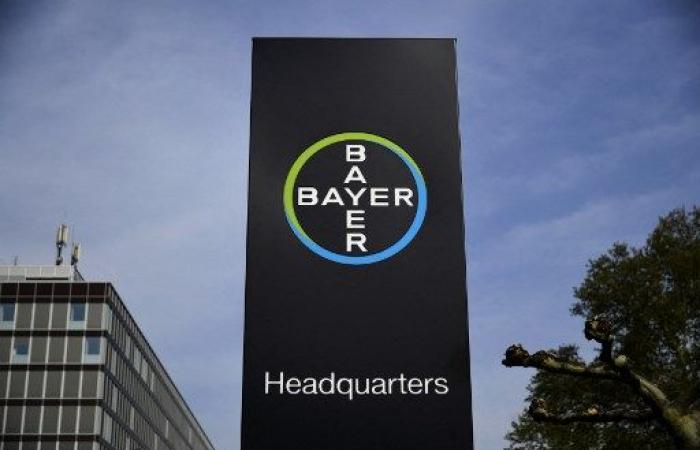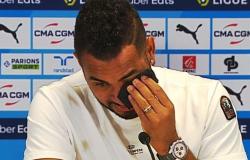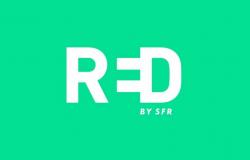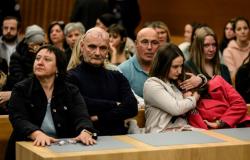
(BFM Bourse) – The German chemicals group delivered results significantly below expectations in the third quarter, and lowered its Ebitda forecast for the current year.
Bayer signs the big drop of the day on the European markets. The German chemical group present in health, pharmaceuticals, seeds, herbicides and insecticides dropped 12% at the start of the afternoon in Frankfurt, after publishing its third quarter results. The company's stock shows the biggest decline in the DAX 40 index.
Bayer clearly missed the mark in the third quarter and was forced to lower its targets for the year 2024.
From July to the end of September, the company from Leverkusen generated revenues of 9.97 billion euros, down 3.6% in published data over one year and up 0.6% excluding scope and scope effects. foreign exchange. Gross operating income (Ebitda) excluding exceptional items stood at 1.25 billion euros, down 25% year-on-year.
According to a consensus cited by Stifel, revenues were below expectations by 3% and adjusted Ebitda by 11%.
>> Access our exclusive graphic analyses, and gain insight into the Trading Portfolio
Lowered targets
“Development in the agricultural market has been weaker than expected, particularly in Latin America, and the company also continues to face pricing pressure in the crop protection sector,” explained Bill Anderson, the CEO of Bayer, quoted in the press release.
Bayer actually had to deal with sluggish revenues in its agriculture segment, which saw its turnover fall by 3.6% excluding currencies and scope, to 3.986 billion euros, or 6% less than the consensus ( 4.25 billion euros). Notably, sales of glyphosate-based herbicides fell 19.1%, which was only partially offset by growth in insecticides and fungicides.
The pharmacy division saw its revenues increase by 2.3% excluding currency and scope effects, to 4.51 billion euros. Bayer saw sales of Xarelto, an anticoagulant, fall by 23%, a decline which was offset by the jump in sales of its new drugs such as Nubeqa (+83%), in the treatment of prostate cancer and Kerendia ( +96%), to treat kidney failure.
Following this publication, the company confirmed its objectives (excluding currency effects) for profits, cash generation, and growth (-1% to +3%). But the company lowered its adjusted EBITDA growth target, expecting a decline of between 11% and 8% compared to a previous range of -9% to -3%.
At the level of its divisions, the company has lowered both its revenue growth forecast and its Ebitda margin for agriculture (“crop science”), counting on a drop in its turnover ranging from 3% to 1% (compared to -1% to +3% previously), as well as an adjusted Ebitda margin located between 18% and 20% compared to a range of 20% to 22% previously.
Profit and turnover expected to decline in 2025
“Overall, we expect a mixed outlook for revenue and bottom line next year, with profits likely to decline. We plan to accelerate our cost-cutting measures and to improve efficiency in order to partially compensate for this situation and to remain focused on cash conversion,” Wolfgang Nickl, the company's chief financial officer, said in the company's press release.
Last year, the chemist initiated a restructuring which should enable it to generate annual savings of 2 billion euros from 2026. This resulted in 5,500 job cuts in 2024, including 3,200 out of six first months of 2024, said Bill Anderson, cited by AFP.
Bayer also hopes that the United States Supreme Court will take up the lawsuits linked to Roundup, Monsanto's herbicide based on glyphosate accused of being carcinogenic, to clarify the legal situation weighing on the group.
Bayer is currently studying which case to bring before the highest American court, and if it takes it up, “hopes for a decision during the 2025-2026 session”. “The road is long and there is no silver bullet,” commented Bill Anderson.
In 2022, the group suffered a first failure, the Supreme Court having then refused to take up two decisions on individual cases.
Since the acquisition of Monsanto in 2018, the chemist has paid around $11 billion to settle more than 100,000 complaints.
According to the Washington Post newspaper, the agrochemical giant is also trying to influence the vote on the future American agricultural law, renewed by the end of the year and which regulates the sector for a period of 5 years.
(With AFP)
Julien Marion – ©2024 BFM Bourse





